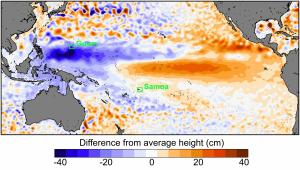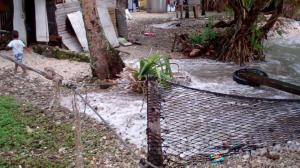Extreme Pacific sea level events to double in future
University of Hawaiʻi at MānoaPostdoctoral Fellow, IPRC, School of Ocean and Earth Science and Technology
Axel Timmermann, (808) 956-2720
Oceanography Professor, IPRC, School of Ocean and Earth Science and Technology
Many tropical Pacific island nations are struggling to adapt to gradual sea level rise stemming from warming oceans and melting ice caps. Now they may also see much more frequent extreme interannual sea level swings. The culprit is a projected behavioral change of the El Niño phenomenon and its characteristic Pacific wind response, according to recent computer modeling experiments and tide-gauge analysis by scientists Matthew Widlansky and Axel Timmermann at UH Mānoa's International Pacific Research Center and their colleague Wenju Cai at CSIRO in Australia.
During El Niño, warm water and high sea levels shift eastward, leaving in their wake low sea levels in the western Pacific. Scientists have already shown that this east-west seesaw is often followed six months to a year later by a similar north-south sea level seesaw with water levels dropping by up to one foot (30 cm) in the Southern Hemisphere. Such sea level drops expose shallow marine ecosystems in South Pacific Islands, causing massive coral die-offs with a foul smelling tide called taimasa (pronounced [kai’ ma’sa]) by Samoans.
The team of scientists recently asked, how will future greenhouse warming affect the El Niño sea level seesaws? The scientist used state-of-the-art climate models, which accounted for increasing greenhouse gas concentrations, together with simulations of the observed climate and tide-gauge records to verify the model results. They determined that projected climate change will enhance El Niño-related sea level extremes. By the end of this century the experiments show that the intensified wind impacts of strong El Niño and La Niña events are likely to double the frequency of extreme sea level occurrences, especially in the tropical southwestern Pacific.
“From our previous work, we know that toward the end of a very strong El Niño event, the tide-gauge measurements around Guam quickly return to normal reflecting the east-west seesaw, but those near Samoa continue to drop as a result of the lagging north-south seesaw,” explains Widlansky. “During these strong events, the summer rainband over Samoa, called the South Pacific Convergence Zone, shifts toward the equator and alters the trade winds and ocean currents which in turn change the sea level.”
“The next logical step in our work was to understand how future changes in winds, projected by most climate models, will impact the interannual swings in sea level,” recalls Timmermann. “We noted a trend in greater variability and were surprised at first to find not only more frequent and prolonged drops in sea level, but also more frequent high sea level events. This will further increase the risk of coastal inundations.”
“Our results are consistent with previous findings that showed the atmospheric effects of both El Niño and La Niña are likely to become stronger and more common in a future warmer climate,” explains Cai.
“The possibility of more frequent flooding in some areas and sea level drops in others would have severe consequences for the vulnerable coastlines of Pacific islands,” says Widlansky.
The authors hope that better predictability of not only rising sea levels, but also the sea level fluctuations examined in this study, will aid Pacific Island communities in adapting to the impacts of climate change as well as shorter-term climate events such as the ongoing 2015 El Niño.
* * *
More information, including a copy of the paper, can be found online at the Science Advances press package at http://www.eurekalert.org/jrnls/sciadvances/ or at http://advances.sciencemag.org/content/1/8/e1500560.
Citation: Widlansky, M.J., A. Timmermann, and W. Cai, 2015. Future extreme sea level seesaws in the tropical Pacific. Science Advances, doi: e1500560.
Funding came from the U.S. National Science Foundation.
Full image caption (top): Extreme low sea levels occurred during August in parts of the western Pacific associated with the ongoing strong El Niño. Data from AVISO satellite measurements. Credit: Widlansky, et al. (2015)
For more information, visit: http://iprc.soest.hawaii.edu/


